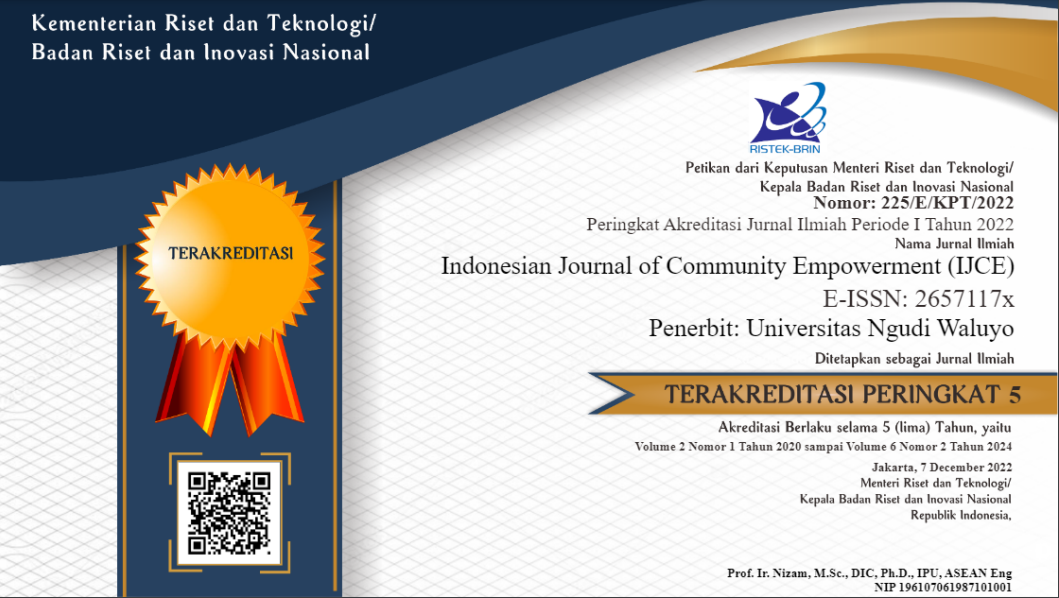Edukasi Tentang Minum Jahe untuk Mengatasi Nyeri Menstrusi Remaja Putri
DOI:
https://doi.org/10.35473/ijce.v5i2.2644Keywords:
Minuman Jahe, Nyeri MenstruasiAbstract
Menstrual pain is painful in nature, felt in the lower abdomen, down to the waist and thighs, can be accompanied by nausea and even vomiting, and even headaches (Haryono, 2016). Dysmenorrhea is menstrual cramps or menstrual pain that occurs mainly in the lower abdomen, but can spread to the lower back, waist, pelvis, upper thighs and calves (Sinaga, 2017). Dysmenorrhea is a disorder of the menstrual cycle characterized by pain (Made, 2014). The incidence of dysmenorrhea in adolescents in Asia is 74.5%. In Hispanic adolescent girls, the prevalence of dysmenorrhea is 85%, while the incidence rate in Indonesia is 55% (Setyowati, 2018).Non-pharmacological treatment of menstrual pain that can be used as an alternative choice in the treatment of primary dimenorrhea is: warm compresses, exercise, diet management, cutaneous massage, heat therapy, relaxation and herbs. (Setyowati, 2018).The rhizome of ginger, Zingiber officinale R. has traditionally been used to reduce inflammatory symptoms. Treatment of primary dysmenorrhea in female students with ginger for 5 days has a significant effect on reducing the intensity and duration of pain (Rahnama et al, 2012), and research by Chen et al, (2016) shows that oral ginger can be an effective treatment for menstrual pain. The findings of Lakhan et al, (2015) show that Zingiberaceae extract is a clinically effective hypoalgesic agent and shows a better safety profile than non-steroidal anti-inflammatory drugs. Various benefits of consuming ginger regularly: relieve menstrual pain, lower glucose and cholesterol, strengthen the immune system, ward off bacterial and viral infections, the gingerol content in ginger is believed to inhibit bacterial infections. such as shigella, E.coli, etc., relieve muscle pain, and overcome digestive problems.
ABSTRAK
Nyeri menstruasi sifatnya nyeri, terasa di bagian perut bagian bawah, sampai ke pinggang dan paha, bisa disertai mual bahkan muntah, bahkan sampai dengan nyeri kepala (Haryono, 2016). Dismenorea adalah kram menstruasi atau nyeri menstruasi yang terjadi terutama pada perut bagian bawah, tetapi dapat menyebar hingga ke punggung bagian bawah, pinggang, panggul, paha atas, hingga betis ( Sinaga, 2017). Dismenorea adalah gangguan pada siklus menstruasi yang ditandai dengan nyeri (Made, 2014) Angka kejadian dismenorea pada remaja di Asia adalah 74.5%. Pada remaja putri hispanic prevalensi dismenore sebesar 85%, sedangkan angka kejadian di Indonesia alah 55% (Setyowati, 2018).Penanganan nyeri menstruasi secara non farmakologis yang dapat digunakan sebagai alternatif pilihan dalam pengobatan dimenore primer adalah: kompres hangat, olahraga, pengaturan diet, masase kutaneus, terapi panas, relaksasi dan herbal. (Setyowati, 2018).
Rimpang jahe, Zingiber officinale R. secara tradisional telah digunakan untuk mengurangi gejala inflamasi. Pengobatan dismenore primer pada mahasiswi dengan mengkonsumsi jahe kemasan serbuk yang diseduh dengan air panas dan dikonsumsi sehari 1 kali pagi dan sore selama 5 hari berpengaruh signifikan terhadap penurunan intensitas dan durasi nyeri (Rahnama et al, 2012), dan Penelitian Chen et al, (2016) bahwa jahe oral dapat menjadi pengobatan yang efektif untuk nyeri menstruasi. Temuan Lakhan et al, (2015) menunjukkan bahwa ekstrak Zingiberaceae merupakan agen hipoalgesik yang efektif secara klinis dan menunjukkan profil keamanan yang lebih baik daripada obat antiinflamasi nonsteroid. Berbagai manfaat mengkonsumsi jahe secara rutin : meredakan nyeri haid, menurunkan glukosa dan kolesterol, memperkuat sistem imun, menangkal infeksi bakteri dan virus, kandungan gingerol dalam jahe dipercaya bisa menghambat infeksi bakteri. seperti shigella, E.coli, dan lain-lain, meredakan sakit otot, dan mengatasi masalah pencernaan salah.
References
Agarwal, A. K., & Agarwal, A. (2010). A study of dysmenorrhea during menstruation in adolescent girls. IJCM: official publication of Indian Association of Preventive & Social Medicine, 35(1), 159–164
Coco A. S. (1999). Primary dysmenorrhea. American family physician, 60(2), 489–496.
Dugasani, S., Pichika, M. R., Nadarajah, V. D., Balijepalli, M. K., Tandra, S., & Korlakunta, J. N. (2010). Comparative antioxidant and anti-inflammatory effects of [6]-gingerol, [8]-gingerol, [10]-gingerol and [6]-shogaol. Journal of ethnopharmacology, 127(2), 515–520.
French L. (2005). Dysmenorrhea. American family physician, 71(2), 285–291
Glenn, L. L., & Dinsmore, K. R. (2018). Effectiveness of Health Education and Promotion for Influenza Immunization. Workplace health & safety, 66(1), 4.
Harel Z. (2012). Dysmenorrhea in adolescents and young adults: an update on pharmacological treatments and management strategies. Expert opinion on pharmacotherapy, 13(15), 2157–2170.
Hosseinlou, A., Alinejad, V., Alinejad, M., & Aghakhani, N. (2014). The effects of fish oil capsules and vitamin B1 tablets on duration and severity of dysmenorrhea in students of high school in Urmia-Iran. Glob J Health Sci, 6(7 Spec No), 124–129.
Ju, H., Jones, M., & Mishra, G. (2014). The prevalence and risk factors of dysmenorrhea. Epidemiol Rev, 36, 104–113.
Minarva, M., Malathi, K.V., Bhanupriya R., (2018) A Study To Assess The Effectiveness Of Information Education And Communication (Iec) On Knowledge And Practice Of Nutritional Status Among Adolescent Girls In Selected High Schools Of Kolar Taluk, Int. J. Adv. Res.; 6(6), 988-992
Mohammadi K, Tavafian S, Ghofranipoor F, Amin-Shokravi F. Health education program and tuberculosis preventive behaviors. Zahedan J Res Med Sci. 2012;14(10):97–9
NFHS-3.(2011) Nutritional status of adults retrieved. Himalaya publishing house,;(3):11-26.
Oladosu, FA; Tu, FF; Hellman, KM (2018) Resistensi obat antiinflamasi nonsteroid pada dismenore: Epidemiologi, penyebab, dan pengobatan. Saya. J. Obstet. Ginekol. , 218 , 390–400
Zhang J. (2013) Meta analysis of tuberculosis health education effect of junior and senior high school students in China. Chin J School Health.;34(11):1367–70.



